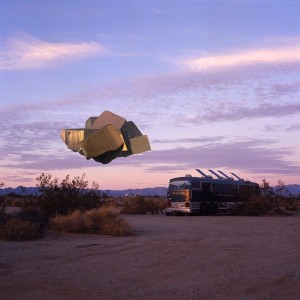 Jessica Eaton, cfaal 109, archival pigment print, 2011
Jessica Eaton, cfaal 109, archival pigment print, 2011
Clint Roenisch has made a reputation in Toronto as a gallerist willing to support what too often are called "avant-garde" artists. However his own approach and the approach of those he represents is refreshingly traditional: well thought out, well executed work presented in a respectful way. It's further proof an educated personal taste and confidence combined with professional standards are still valid ethics in the business and art worlds concurrently.
 Chris Cran, Portrait of BG, oil and acrylic on canvas, 2006
Chris Cran, Portrait of BG, oil and acrylic on canvas, 2006
Joseph Staples: You've been incorporated in Toronto since 2003. Can you talk about where you came from, what drove you to art and how you became an art dealer?
Clint Roenisch: I studied art history at Queen's and later I was a curator at two small public museums and then in 2001 a Vancouver gallerist asked me to open a space for them in Toronto. I directed that for two years and then opened my own space on November 22nd, 2003, coincidentally the same day Kennedy was shot forty years prior and the same day Marcel van Eeden, an immensely talented Dutch artist I represent and whose work has to do entirely with the period before his own birth, was born. I had been intrigued by the possibilities of art since I was a teenager in Calgary and Doug Maclean, who for many years ran his gallery - Canadian Art Galleries - there, was always very patient and welcoming when I would visit as an inquisitive teenager. After university when I worked as a curator I was thrilled to realize that it could be someone's job to be around artists and talk with them and work on shows and publications together and help to present their worldview to other people.
 Niall McClelland, Rubber Maiden, hung rubber mesh, 2011
Niall McClelland, Rubber Maiden, hung rubber mesh, 2011
One of my first exhibitions - enabled by a very sympathetic and encouraging director, Carolyn Vesely (now at the Ontario Arts Council) - was a forty-year survey of paintings by an artist I had long admired, the late Montreal artist Guido Molinari. To be able to linger in his studio and understand half of what he was talking about, in terms of painting and perception and the elasticity of the brain's mechanics, was very inspiring. He died in 2004, under-appreciated in my opinion. Eventually I realized I wanted to be involved in something that moved faster than museums do so when the chance to direct a commercial gallery presented itself I didn't hesitate.
Being free from museological restraints was liberating but the foregrounding of the fiduciary aspect of everything also forced a kind of recalibration. Now it was primarily about sales so the gallery could continue but, thankfully, the sales were of credible work by credible artists. I never felt my integrity was threatened. In 2003 I had the chance to open my own space and although at the time I thought my name was too clunky and I did not have much money or any real backing, I went ahead. I opened my own gallery so that I could have a say in what got seen and I'm thankful it's still here nine years later.
 Dorian Fitzgerald, Elton John's Sunglasses, Woodside Estate, Old Windsor, England, acrylic and caulking on canvas. 2010
Dorian Fitzgerald, Elton John's Sunglasses, Woodside Estate, Old Windsor, England, acrylic and caulking on canvas. 2010
JS: That turn of phrase, "credible work by credible artists", is one that I imagine is an ideal most gallerists would aspire towards. In looking at the artist's you represent, the only obvious connection is a seriousness of practice and a depth of understanding in the materials that they use to compose work, despite differences in length of career or notoriety. How would you connect the artists you work with back to you and your concept of the gallery?
CR: I meant credibility in that I was leaving the curatorial world to work for a commercial gallery that had credible artists; it was a good offer. But ultimately it was another gallerist's vision and I wanted my own. The artists I work with now - despite the generations-gap between the oldest and the youngest - each interrogate their own practice with an eye to art history and what came before them. None of them are dilettantes; all of them scrutinize their respective mediums even when they work across many fronts the way Jason de Haan and Tony Romano do. And each of them presents to me a vision of the world that I find penetrating and unique. Lastly that each in their own way speak, either obliquely, like Harold Klunder does with his primordial paintings, or directly, like Marcel van Eeden with his obsession with his "pre-history," to the transience of our time here. A brief blip for each of us is all we get.
 Tony Romano, Waiting for Blue, c-prints, 2010
Tony Romano, Waiting for Blue, c-prints, 2010
JS: History and death are more prevalent themes in the contemporary art world. Yet in better work it may not be obvious, like Tony Romano's Waiting for Blue. Contemporary culture seems to push us away from our impermanence and the past we come from. I think there is an understanding with your artist line up that you are not selling landscape paintings, but do you find these themes can be alienating or bitter to the public once the surface layer is pulled back on the work?
CR: What I said about transience was meant in a more positive way: Klunder's paintings, to continue the example, are shot through with vitality and erotic desire. They are fecund and rich with commingling figures, odes to being alive now. The collective T&T (Tony Romano and Tyler Brett) habitually look at post-apocalyptic/ post-oil scenarios in their work. But instead of being unrelievedly dark, as in Cormac McCarthy's The Road, they have distilled out the optimistic, adaptable aspects of the situation and present communal bands of people solving problems of shelter and resource-gathering in elegant, ingenious ways. The British artists Heather and Ivan Morison, who just finished an outdoor commission for the Tate Modern, are engaged in some of the same themes.
 Heather and Ivan Morrison, Dark Star, Medium format transparencies transferred to HD video and collaged with CGI imagery, 2007
Heather and Ivan Morrison, Dark Star, Medium format transparencies transferred to HD video and collaged with CGI imagery, 2007
JS: Your show Black To Back And Light of Niall McClelland and Jeremy Jansen with Ellsworth Kelly and Richard Serra was like a museum show and put the elder and junior artists in a complimentary light. This type of contrasting of younger and senior artists would only been seen in a museum 30 years ago. Do you feel it's the gallery's responsibility to educate the public as well as make sales or is it simply a role you choose to accept?
 Black To Back And Light installation, Clint Roenisch Gallery, 2009
Black To Back And Light installation, Clint Roenisch Gallery, 2009
CR: That's kind of you to say it was museum-worthy. I think that the commercial galleries in every city in the world do a great public service, albeit inadvertently. Every six weeks there are great new shows opening and they are free for anyone to just walk in. Strong, deeply-considered contemporary, modern and historical shows. Certainly the blossoming of interest in contemporary art over the last ten years is a boon to the galleries but whether they are actively interested in educating the public... I don't think so. I think putting on an authentic, persuasive show educates by osmosis. I just knew that the dark, formal strengths of Kelly and Serra would dialogue well with the sneering elegance of young McClelland's folded photocopies and the punk energy of Jansen's sculpture and images.
 Roger Ballen, Retreat, Silver gelatin print, 2005
Roger Ballen, Retreat, Silver gelatin print, 2005
JS: You made the leap to the art fair circuit fairly quickly from your initial opening. Do you feel this is an essential part of being a dealer in today's market or a "necessary evil"? How have they affected the way that you do business?
CR: They are so useful to a Canadian gallery because so few international collectors roll through, relative to New York or London. When I did the NADA Fair last May in New York we had such a crush of people right from the opening hour. Aleksander Hardashnakov, a Toronto painter without equal in Canada, had such interest from that fair that we sold nearly everything that weekend and it also led to him having his first solo show in New York, which is on now at Martos Gallery on 29th in Chelsea through December. None of that would have happened if I hadn't done that fair. Also with artists like Marcel van Eeden (whose small drawings are a few thousand euros now) there is less resistance to prices at fairs than there is in Canada. Collectors outside of Canada don't question it and even think of them as a bargain. But in Toronto it can be a different story. Meanwhile Canadian artists generally make strong, undervalued work so when you bring them to a foreign fair, even if they aren't known to a foreign audience, there is often immediate interest because the work is good and the prices are very reasonable.
 Jimmy Limit, Fruit Tape Basketball Tower (accuracy, anger, architecture, assemblage, competition, cooperation, danger, excitement, fun, hope, level, prosperity, succulent, support, tradition), 2012
Jimmy Limit, Fruit Tape Basketball Tower (accuracy, anger, architecture, assemblage, competition, cooperation, danger, excitement, fun, hope, level, prosperity, succulent, support, tradition), 2012
JS: With the popularity world wide of Canadian art bigger than ever and pricing within the country lower than abroad, new collectors in Canada are in a unique position. How would you describe the life of the collector? What would you say to a new collector in this environment?
CR: Collecting art can become a life-long obsession. Every person that begins a collection ends up making their own self-portrait via the works they've chosen to surround themselves with. A collection can come to represent the collector's worldview and it can often reveal the collector to herself in a way that nothing else can. Becoming a collector starts with looking and then more looking and then talking with gallerists, curators and artists.
Part of the pleasure of becoming a collector is taking part in the many social aspects of the contemporary art world: going to openings, to artist's studios, to museums and to art fairs introduces you to people you would never otherwise meet, to artists and fellow collectors and that can help open your mind in a way that helps you, in turn, with your business life. Plus I have to say, the person that takes an aesthetic and fiduciary risk to begin collecting art immediately makes them more intriguing in a way that investing in the stock market doesn't.
All images courtesy Clint Roenisch. For more information on the gallery and the artist's featured, please visit Clint Roenisch Gallery.























Mr. Roenisch pretty much nailed it with that last paragraph.
Indeed.